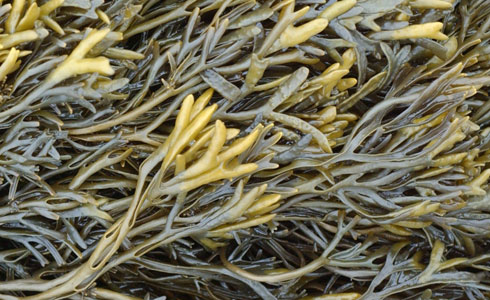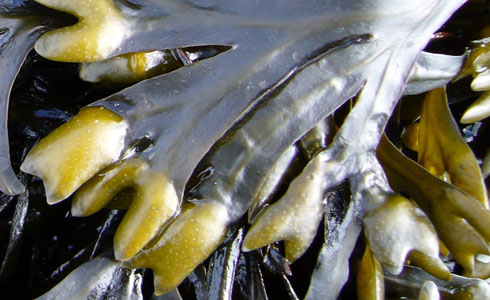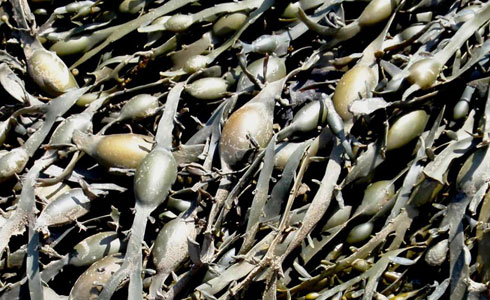How do seaweeds on the upper shore retain their moisture when the tide is out? And how can you tell how exposed the upper shore is? Find out more.
Channelled wrack, Pelvetia canaliculata
Location: Channelled wrack is found right at the top of the beach where it can dry out completely to become black and crispy.
Identification: Fronds are rolled lengthwise to form a channel. You may see bumpy, v-shaped swellings at the ends of the fronds, which are its reproductive structures. It grows to about 15cm long.
Facts: The channelled fronds help it to retain moisture when the tide is out, which is partly why it can grow so high up on the shore. It can survive several days without being covered by the tide and often only gets splashed by the sea’s spray. In fact it requires these relatively dry conditions - if channelled wrack is completely submerged in water for a long time, it will die.
A close-up of channelled wrack, Pelvetia canaliculata
Spiral wrack, Fucus spiralis
Location: Spiral wrack is found on the upper part of the shore.
Identification: The fronds are flattened, with straight edges and a mid-rib. This species often grows with the fronds twisted into a spiral. During the summer you may see bumpy v-shaped swellings with distinct rims at the ends of the fronds. These are its reproductive structures. Its fronds can grow to 70cm long. This species looks similar to toothed wrack, but can be separated because its fronds have smooth edges.
Facts: Spiral wrack curls as it dries in order to conserve moisture. People used to believe that if they soaked their feet in boiling water that contained the reproductive parts of this seaweed, it would cure their corns.
A close-up of spiral wrack, Fucus spiralis
Bladder wrack, Fucus vesiculosus
Location: Bladder wrack is usually found on the middle shore.
Identification: Bladder wrack has round air bladders that look like bubblewrap, usually in pairs either side of the mid-rib. Its fronds can grow up to 1m long.
Facts: The air bladders allow the seaweed to float upright when underwater. The number of air bladders on each frond depends upon how exposed the shoreline is – on exposed shores bladder wrack has fewer air bladders than on sheltered shores.
A close-up of bladder wrack, Fucus vesiculosus
Egg wrack, Ascophyllum nodosum
Location: This species occurs in sheltered areas where it can be very abundant on the middle part of the shore.
Identification: Egg wrack has single, large (1-5cm long) egg-shaped air bladders growing along the length of its strap-like fronds. Fronds can grow up to 1.5m long.
Facts: Each air bladder equates to 1 year of growth. You may see what look like coarse, woolly red tufts on the fronds - these are actually another species of seaweed called Polysiphonia lanosa, which often grows on egg wrack.








